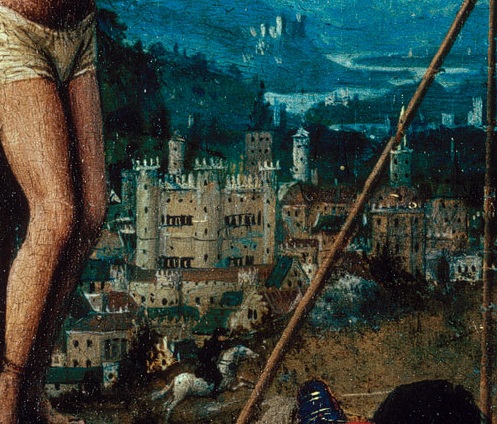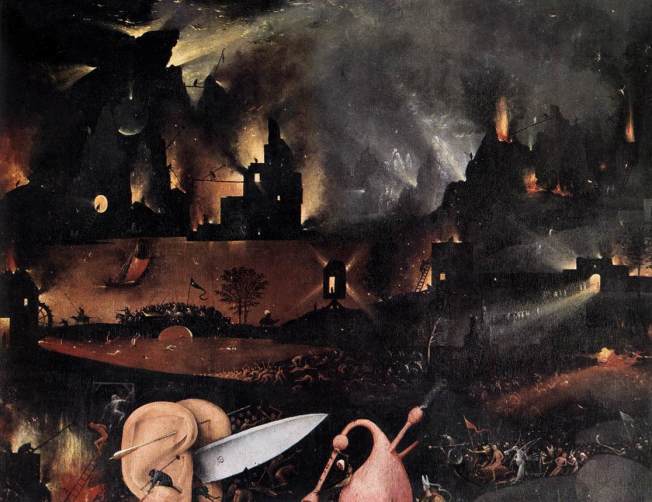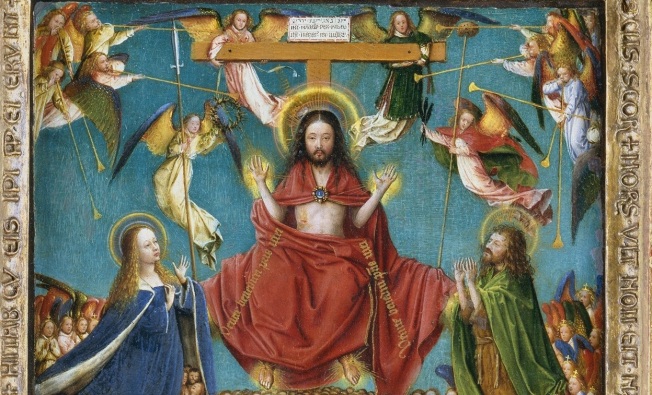
The frames of Jan van Eyck’s (born circa 1390 – died July 9, 1441) diptych masterpiece, The Crucifixion and the Last Judgment, each measure just 22.2 inches high and 7.8 inches wide; yet, they depict the horror of these two biblical events in great detail.

The Crucifixion and the Last Judgment by Jan van Eyck
The left-hand panel is the crucifixion scene. Christ’s followers grieve in the foreground. St. John supports Mary, the mother of Jesus. From the gospel record, we surmise that the two women looking on and weeping are Salome (wife of Zebedee and mother of the apostles James and John) and Mary, the wife of Cleophas. Nearby, in the green robe, is Mary Magdalene, her eyes on her crucified Savior.

Detail of The Crucifixion
The middle ground of the painting holds other onlookers, some concerned, some indifferent, and some sneering, including Roman soldiers, high priests, and temple elders.

Detail of The Crucifixion

Detail of The Crucifixion
At the top of the panel are the three crosses at Golgotha where Jesus and two thieves were executed. A soldier has just plunged a spear into the already-dead Christ’s side. Jerusalem is visible in the background.

Detail of The Crucifixion

Detail of The Crucifixion
The right hand panel of the diptych, depicting the Last Judgment, is also divided horizontally into three areas, representing (from top to bottom) heaven, earth and hell.
The entrance to hell seems to be the rear end of a skeletal representation of Death. The souls drop in head first to be tormented by demons with tentacles and mouths full of sharp, pointed fangs ready to tear them apart. Some of the damned appear to be clergy and royalty–undoubtedly a risky undertaking for van Eyck.

Detail of The Last Judgment

Detail of The Last Judgment
This scene reminds me of The Garden of Earthly Delights by Hieronymus Bosch (c. 1450 – 9 August 1516).

The Garden of Earthly Delights by Hieronymus Bosch

Detail of The Garden of Earthly Delights
Back to van Eyck’s Last Judgment, between heaven and hell, the dead rise from their graves and from the sea. The Archangel Michael stands on death’s shoulders.

Detail of The Last Judgment
The upper portion of the panel shows the second coming of Christ. Four angels hover around Him, holding the cross (the symbol of our salvation), a crown of thorns, nails, and a sponge upon a spear. An angelic choir blows trumpets.

Detail of The Last Judgment
The Apostles, dressed in white robes, sit on two facing benches below Christ. Two angels usher the groups gathered at each side of the benches.

Detail of The Last Judgment
The heavenly portion of this panel is considered to have been painted more broadly and with less skill than the other sections, and is thusly attributed to other members of van Eyck’s workshop.
During the Renaissance, there were no art schools. In order to learn the art of painting, one needed to serve an apprenticeship to a master painter in his workshop.
Most apprentices entered artists’ shops in their early teens because they were members of families already engaged in painting, or because their parents decided that their son would become a painter or sculptor. Talent was not a requirement. He was there to learn a craft, and to make the master’s style his own. The artist Cennino Cennini (1370-1440) stated in his shop manual that the apprentice should not experiment with his own style until he had learned to duplicate his master’s.
The apprentice’s task was to assist the artist in the preparation of materials and, once the design had been formulated, to help him produce the work. More often they did the less important and quite tedious decorative parts of frescoes or statues.
The apprenticeship could last a decade or more. Training involved a series of progressive steps from grinding pigments, to copying, to executing the master’s design, and finally to creating one’s own artwork.
For more detailed information about these topics, click the links below:
- a discussion of the role of the apprentice in painter’s workshops and apprenticeship programs
- an in-depth analysis of van Eyck’s Crucifixion and Last Judgment diptych
- a painter’s take on The Last Judgment
Now it’s your turn. New in 2023: This article is by far the most visited post on this website. I’m curious. How did you happen to come to it? Were you looking for information about this particular painting? Was the article assigned to you for homework? Please share your answer in the comments below.
Really interesting, Andrea.
LikeLiked by 1 person
Breathtaking art, brought me to tears. When you’ve seen such religious art of the masters in person (We visited art galleries in Venice) and learn of the patience and skill and beauty given to us by the artists, you are speechless. Thanks for sharing.
LikeLiked by 1 person
This was fascinating. I’ve seen van Eyck’s Ghent Altarpiece, and it would be interesting to compare the two works of art.
LikeLiked by 1 person
Thank you, Marylee. I had to look up the Ghent Altarpiece. I’m so jealous you’ve seen it in person. Great article about it here: https://www.thedailybeast.com/why-hitler-and-hermann-goring-went-to-war-over-the-ghent-altarpiece.
LikeLike
Wow, fantastic paintings!
LikeLiked by 1 person